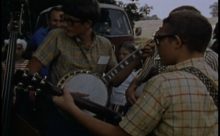Making the Film
I filmed It Ain't City Music over a two-year period, the Contests of '71 and '72. I got together a film crew, basically a second camera and soundman. I borrowed sync sound equipment. I shot the sync sound material and the second cameraman did the cutaways and close-ups. In the first shooting I tried photographing in a way similar to my stills, basically a frontal image, in which I didn't get too close to the subject: a medium distance shot. We soon discovered we needed more close-ups because in a still photo there is time to absorb all the elements of the picture. You can vary the distance between the still photo and your eye - but this isn't possible in film. There's one cinema verite method of filming that attempts to disguise the camera's presence (e.g. An American Family) but the camera is never really forgotten, it's always there. In IACM I wanted to create instead the style of local TV reporting which I find refreshing in its naive approach. The microphone is visible in many shots and people respond directly to the camera.
Altogether, for this fifteen-minute film I had about four hours of sync and wild material to select from. The editing principle appears simple, a combination of music and interviews, but actually It Am't City Music was a very difficult film to edit. The danger of a pattern such as we used is boredom and repetitiveness, so a dynamic relationship between the music and the interviews had to be arrived at. I almost feel that the first cut decides where you're going because once that first scene is chosen, the rest of the film will generate its own order. When that order is violated it will take a lot of time to find what the film actually demands. Mostly, it's a sense of discovery.
I read in an article about Robert Flaherty's Nanook of the North a description of how the Eskimos created things. They-would pick up a piece of ivory, look at it, handle it, move it around in their hands to discover what was in that ivory and, as they worked, slowly, carving here, nicking there, they would finally discover what was to be made of it, a seal, a walrus or a polar bear.
